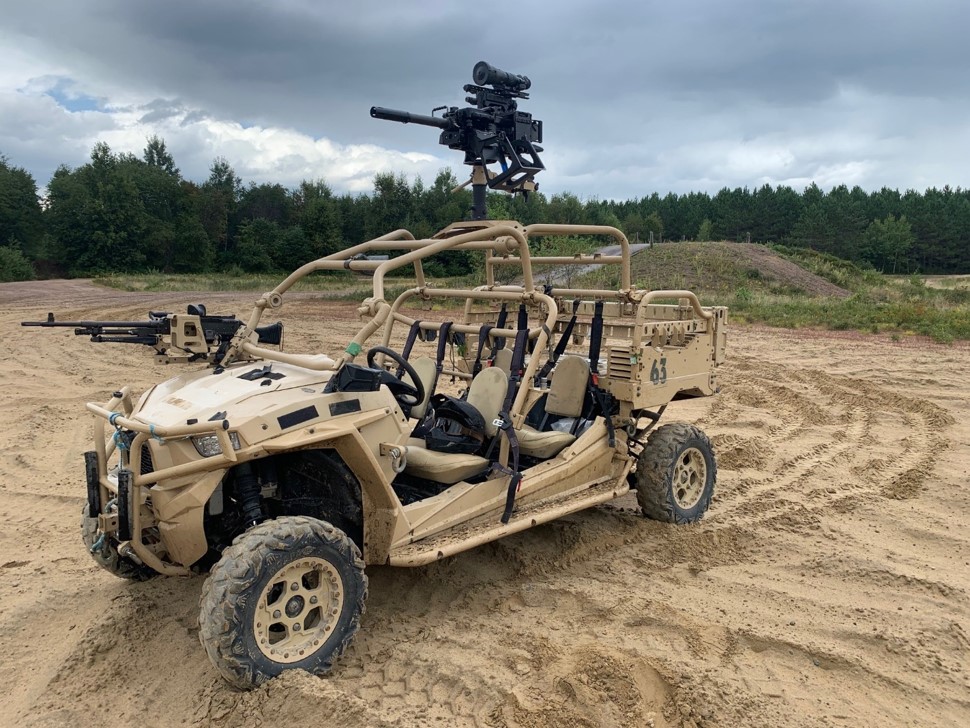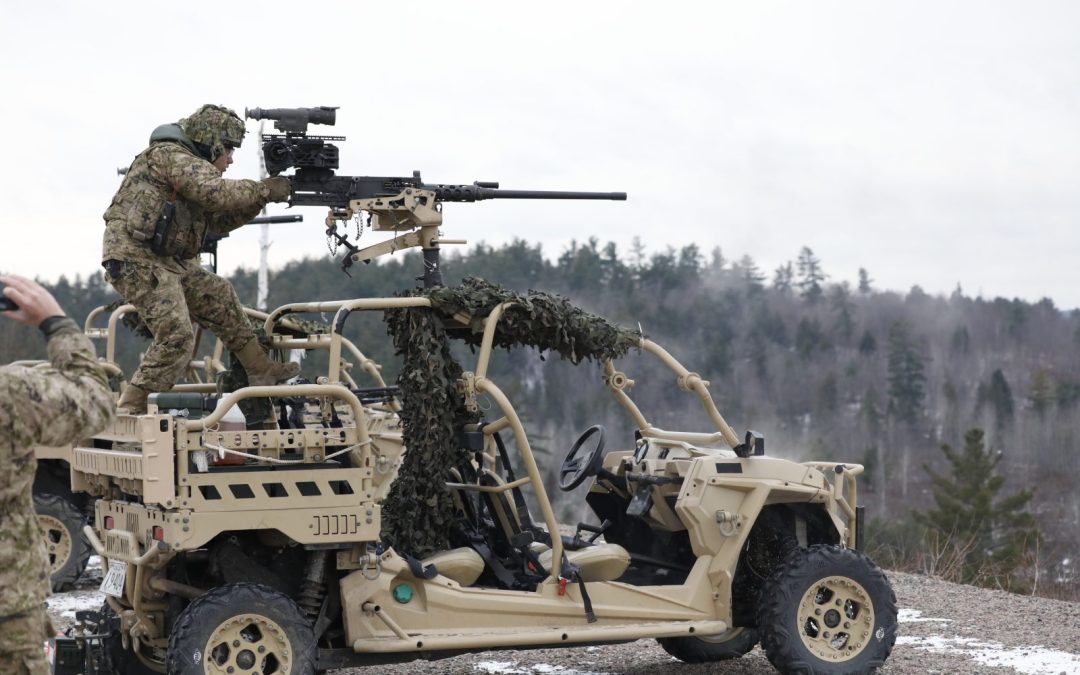by Chris Thatcher
Inflation is having a deflating effect on defence procurement and the Light Forces Enhancement (LFE) project is no exception. But beyond the growing costs of manufacturing a four-wheeled, lightweight, off-road vehicle, the Army now knows it will need a more robust — and consequently, more expensive — version than originally envisioned.
Since acquiring 36 Polaris MRZR-D four-wheeled utility task vehicles and 12 trailers as part of a “buy-and-try” in 2017 and 2018, the Army’s three light infantry battalions have put the platforms through a range of operational scenarios and provided the LFE protect team with plenty of feedback about what will ultimately be required to be effective on operations.
The battalions have in general given the capability favourable reviews. The MRZR-Ds have proven the Army’s concept of getting soldiers and gear to a target more quickly and in better condition than if they had hiked in on foot. But the off-road tests revealed the need for a sturdier platform to navigate obstacle crossings in wetlands, forests, and other difficult terrain.
That robust requirement was confirmed again this past fall during a weapons trial. Members of the 3rd Battalion, The Royal Canadian Regiment (3 RCR), conducted a static range test with a mounted .50 caliber heavy machine gun, a 40 mm grenade launcher, and a BGM-71 TOW (Tube-launched, Optically-tracked, Wire-guided) heavy anti-tank missile.
While the grenade launcher performed well, the TOW required some additional manoeuvring to adjust the weapon’s angle for the shot, restricting the shooter to a 30- to 45-degree field of fire while standing in the cargo area. And because the vehicle’s suspension could not keep pace with the .50 calibre gun’s recoil, the weapon had to be fired at a slow rate.
“You will have one bullet on target and one bullet way low or way high, so the shooter, to ensure the suspension does not move a lot, had to go almost single shot by single shot. And that doesn’t make sense for that kind of weapon system,” said Major Samir Khelil, project director with the Directorate of Land Requirements (DLR), who observed the weapons range tests.
“That led us to confirm that we need a turret in the vehicle to be able to cover 360 degrees, so the shooter can be standing and have a proper position to sustain a few minutes of firing. If you are not comfortable behind the optics, you will probably just squeeze the trigger just to squeeze the trigger.”
Trials by 3 RCR and the Army’s other two light battalions with the Royal 22nd Regiment and the Princess Patricia’s Canadian Light Infantry have also demonstrated that the payload capacity must be larger to transport enough weapons, ammunition, personal equipment, water and rations to sustain a unit well beyond 72 hours. Previously, the project had requested carrying capacity for a maximum of three days.
“The future concept for the light forces — for those light companies or battalions or combat teams — requires that they be self-sufficient operating in different environments,” Khelil explained.
The battalion plans to continue trials with the tactical mobility platforms (TMP), incorporating the MRZR-Ds into a spring exercise to further test concepts of operation, but the DLR team is now ready to engage again with manufacturers to gather fresh data on vehicle cost.
The need for a more robust frame and the effects of inflation could mean a smaller initial buy, acknowledged Khelil, an infantry officer with the Royal 22nd Regiment, with domestic and international operational experience. The project will be seeking better data on market conditions through a request for information (RFI) to be issued in the next few months.
The Army had yet to settle on final quantities but had projected a buy of up to 300 TMPs in two variants — personnel and cargo — to equip the three light infantry battalions, the light engineer squadrons, and the light artillery tactical groups.
Depending on the feedback from the RFI, the project team is now estimating around 90 tactical vehicles, still in the same two variants, plus nine to 10 trailers. The majority, around 60, would be in the troop-carrying variant.
“We are focusing right now on the core capability of the light forces,” Khelil explained. That would mean equipping one light force battle group, which includes a light infantry battalion, a light engineer squadron, and a light artillery battery.
“That’s the minimum scope,” he added. “A middle scope would increase the amount up to 330 vehicles, to equip the three light battalions. The full scope would add around 200 more vehicles to equip Reserve units, including specialists such as pioneers and direct fire support. The Reserve units are one of the main players that will need to use the TMP. But, at this time, we are focused on the minimum scope.”

In previous interviews on the LFE project, the Army emphasized a desire to be “fast followers” and focus on platforms already proven with allied armies. But past project directors also stressed a cost-effective solution and warned of the likely need for a reality check, given the price tag of some off-road platforms — as high as $350,000 per vehicle, they noted — and the project budget of between $50 million and $99 million.
While the project does not specifically call for “green” investment, “we are keeping a door open in our statement of requirements (SOR) regarding green energy,” Khelil said. The advantage of a vehicle that can run almost silent, especially at night, to get soldiers closer to an objective is obvious. But although commercial battery-powered platforms are more common, the technology might not be ready for operations, he said. “In my personal and professional opinion, we are not there yet.”
Light units operate in cold conditions, which can rapidly diminish battery life. And repairing battery-enabled platforms in the field might be a challenge for small combat teams.
“We will observe where the technology is going,” he said, “and have an open door in our SOR for the vehicle to be able to accept that technology in a future modification. We want to have the maximum flexibility possible, so we’ll seek an option to be able to modify the vehicle rather than have to run a new project.”
Like many other projects in DLR, the pandemic delayed LFE progress. The Army had anticipated reaching initially operating capability (IOC) with one of the light battalions by 2025. Khelil said the project will now likely go out for tender by the end of 2024 or early 2025, and achieve IOC in 2028.
“The [light battalions] did a great job with the trials, and it’s now our duty to provide them with a vehicle that is capable and that the troops on the ground trust to accomplish their mission,” he said.
The LFE project is part of a broader effort identified in the government’s 2017 defence policy to purpose-build and equip the light battalions.




